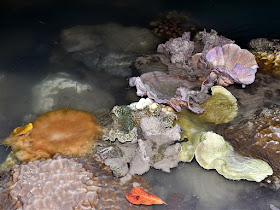How are the corals doing? From this photo, you can see that some species are more affected than others.
In case you are scratching your head wondering what is coral bleaching? Bleaching happens when corals (and also other cnidarians) lose the symbiotic algae in their bodies which help produce nutrients. It is the algae that give the animals their colour. Scientists think that most bleaching is caused by an increase in sea surface temperature. Find out more about bleaching in the Bleach Watch Singapore blog.
Tanah Merah is a special reclaimed shore where different types of corals grow close to each other. From this shot, one can see that some of the not-so-tough corals that first succumb to bleaching include Boulder pore corals (Porites sp.), Circular mushroom coral (Fungia sp.), Thin Disk coral (Turbinaria sp.) and some greenish-looking Anemone coral (Goniopora sp.).
The branching Cauliflower coral (Pocillopora sp.) in the middle is also one of the first few victims of thermal stress in the waters.
This photo shows the bleaching of Boulder pore corals (Porites sp.) and Thin Disk coral (Turbinaria sp.). There's a huge jellyfish on the left!
Some of the Boulder pore corals are already dying as a result of losing their symbiotic algae.
Here's a collage of the different types of bleaching hard corals.
Yet on the other hand, about 70% of the corals are still fine and healthy as they look brown, blue and green. Let's hope they stay resilient!
Surprisingly, I usually do not spot much reef organisms. Probably due to the fact that this shore is one of, if not the toughest shore to navigate. Nevertheless, good to still see the resident Eight-banded butterflyfish (Chaetodon octofasciatus). They mainly feed on coral polyps.
Ian found the pretty China moon snail (Natica onca). This moon snail is not usually sighted.
Since Jianlin's find of the Knobbly sea stars (Protoreaster nodosus) during his survey in May, I was keen to see them for myself. And we were glad to find two baby ones! Other sea stars include the Common sea stars (Archaster typicus) and the Painted sand stars (Astropecten sp.).
At the rocky and seagrass areas, we were surprised to find several types of sea cucumbers.
There are some jellyfishes that got stranded during the low tide. They look a lot better when placed back into the tide pool.
Here's another one that has spots on its surface. Not sure of its identity though.
That's all for the report from this trip. We will be checking another southern shore later this week and will give more updates on coral bleaching.
More photos of the trip can be found here: https://www.flickr.com/photos/koksheng/shares/RM20P1














No comments:
Post a Comment